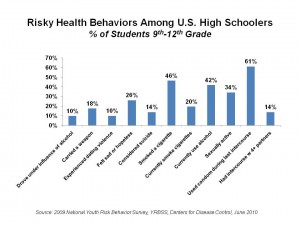 From bad driving behaviors to binge drinking and unprotected sex, the health-state of America’s high school population gets a grade of “R” for “risky.”
From bad driving behaviors to binge drinking and unprotected sex, the health-state of America’s high school population gets a grade of “R” for “risky.”
The 2009 National Youth Risk Behavior Survey is out from the Centers for Disease Control from the good people at the Division of Adolescent and School Health, based on survey data among 16,410 young people grades 9-12 who live in all 50 states and the District of Columbia.
As you read the statistics, keep in mind these are self-reported among kids who are 14-18 years of age. Among the most high-risk health behaviors are the findings that:
- 1 in 10 drove a car when they were under the influence of alcohol
- 27% of boys (1 in 4) carried a weapon (1 in 10 boys overall carried a gun)
- 1 in 10 high schoolers experienced “dating violence”
- 26% of kids felt sad or hopeless; higher among girls at 34%
- 14% of kids considered suicide — 17% girls, 11% boys
- Nearly 1 in 2 high schoolers have tried smoking a cigarette; the good news is this percentage has declined since a high of 71% in 1991; 20% currently use cigarettes daily, a relatively flat proportion for the past few years
- 4 in 10 regularly use alcohol, and 24% report binge drinking
- Among the 34% of currently sexually active students, 61% report they or their partner used a condom during last sexual intercourse
- 14% of students have had sexual intercourse with 4 or more partners during their life.
Other stats cover physical activity, dietary behaviors and obesity.
This survey is conducted biennially to allow for longitudinal data analysis and trends.
Health Populi’s Hot Points: There are some positive developments for risk-management of high schoolers’ health: since 1991, seat belt use is increasing, the percent of students carrying a weapon onto school grounds fell by over half from 11.8% in 1993 to 5.6% in 2009, the proportion of high schoolers who seriously considered suicide fell by over half, and cigarette smoking is down.
On the other hand, risky behaviors around sex, drugs and alcohol continue to challenge young peoples’ health. Cigarettes have become relatively very expensive for kids given the state taxes levied on them, compared to cheap, accessible alcohol. Marijuana use is also up from 14.7% in 1991 to 20.8 in 2009. And unprotected sex is prevalent, notwithstanding two decades’ worth of HIV/AIDS prevention efforts and school programs that educate about STDs.
How to combat the risky health behaviors of kids has as much to do with MTV, Nickelodeon, Jay-Z, Beyonce and texting as it does to do with vaccines, visits to pediatricians, and in-school health classes. The entertainment industry, food and beverage, brewing, and technology companies have large roles to play in enhancing the public health of kids.




 I am so grateful to Tom Lawry for asking me to pen the foreword for his book, Health Care Nation,
I am so grateful to Tom Lawry for asking me to pen the foreword for his book, Health Care Nation,  Thanks to Feedspot for naming this blog, Health Populi, as a
Thanks to Feedspot for naming this blog, Health Populi, as a